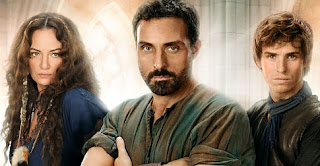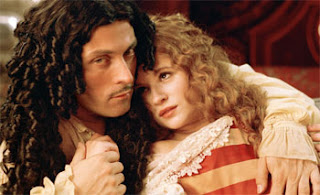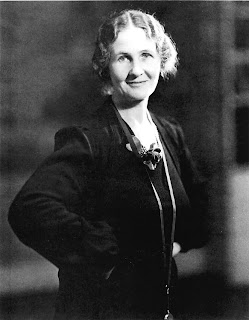 Victoria here. I have been watching a new series based on Ken Follett’s novel Pillars of the Earth. It is on cable channel StarZ on Friday nights. Here is the trailer. Sewell stars as Tom Builder, a master builder of the cathedral at the center of the book. Read more about Follett and the novel here.
Victoria here. I have been watching a new series based on Ken Follett’s novel Pillars of the Earth. It is on cable channel StarZ on Friday nights. Here is the trailer. Sewell stars as Tom Builder, a master builder of the cathedral at the center of the book. Read more about Follett and the novel here. Here is a review of the series and here is another. It is a gritty view of the green and pleasant hills of England, definitely more of the “dark satanic mills” * view, though it takes place long before there were industrial mills.
Here is a review of the series and here is another. It is a gritty view of the green and pleasant hills of England, definitely more of the “dark satanic mills” * view, though it takes place long before there were industrial mills. I first encountered Mr. Sewell when I saw him as the tutor Septimus in Tom Stoppard’s play Arcadia. What a brilliant play and what a brilliant actor. I was in London and really can’t say I knew anything more about it than I liked Stoppard. Later, I found I loved Rufus as well as Tom. And I’ve seen the play two other times, including at the Milwaukee Repertory Theatre.
I first encountered Mr. Sewell when I saw him as the tutor Septimus in Tom Stoppard’s play Arcadia. What a brilliant play and what a brilliant actor. I was in London and really can’t say I knew anything more about it than I liked Stoppard. Later, I found I loved Rufus as well as Tom. And I’ve seen the play two other times, including at the Milwaukee Repertory Theatre. George Eliot (Mary Anne Evans) wrote the brilliant novel Middlemarch in the 1870’s. It was a BBC miniseries in 1994, with Sewell starring as Will Ladislaw, the young love interest of the heroine toward the end of the novel. Whether the two of them have a happy ending is more or less left to the reader’s imagination.
George Eliot (Mary Anne Evans) wrote the brilliant novel Middlemarch in the 1870’s. It was a BBC miniseries in 1994, with Sewell starring as Will Ladislaw, the young love interest of the heroine toward the end of the novel. Whether the two of them have a happy ending is more or less left to the reader’s imagination.  Sewell played Seth Starkadder in Cold Comfort Farm, the wonderful 1995 film made from the Stella Gibbons novel of the same name, published in 1932. It is hilarious and a special treat for British movie fans, if you love the Merchant Ivory films and their like. Poor Rufus, he doesn’t like the “pretty face” type of roles, but he is SO good at them.
Sewell played Seth Starkadder in Cold Comfort Farm, the wonderful 1995 film made from the Stella Gibbons novel of the same name, published in 1932. It is hilarious and a special treat for British movie fans, if you love the Merchant Ivory films and their like. Poor Rufus, he doesn’t like the “pretty face” type of roles, but he is SO good at them.
 Another of his Beautiful People roles was as Marco Venier in Dangerous Beauty, 1998, the story of a Venetian courtesan and poetess. I could just sit here and enjoy uploading pictures of the handsome actor. But that would belie his versatility and the depth of his acting ability. Nevertheless, I can’t resist.
Another of his Beautiful People roles was as Marco Venier in Dangerous Beauty, 1998, the story of a Venetian courtesan and poetess. I could just sit here and enjoy uploading pictures of the handsome actor. But that would belie his versatility and the depth of his acting ability. Nevertheless, I can’t resist.  Sewell has done many Shakespeare roles, such as Fortinbras in Hamlet and Petruchio in Taming of the Shrew, below in modern dress.
Sewell has done many Shakespeare roles, such as Fortinbras in Hamlet and Petruchio in Taming of the Shrew, below in modern dress.
 In the excellent film Amazing Grace about the end of the British slave trade, he played Thomas Clarkson, an ally of Wilberforce.
In the excellent film Amazing Grace about the end of the British slave trade, he played Thomas Clarkson, an ally of Wilberforce. And in 2001’s A Knight’s Tale, Sewell was the evil count Adhemar (below with the late Heath Ledger on the left). I wanted the Count to win!! Or for Heath to wash and comb his hair.
And in 2001’s A Knight’s Tale, Sewell was the evil count Adhemar (below with the late Heath Ledger on the left). I wanted the Count to win!! Or for Heath to wash and comb his hair. Last television season, he starred in Eleventh Hour, a CBS series which ran for 18 episodes. The show had a loyal audience but apparently not enough to be renewed, so it has passed into DVD-dom and probably syndication some day. Sewell was Jacob Hood, a brilliant biophysicist who solved crime questions. He had a protector assigned by the FBI, Rachel Young. I have to admit the scripts were not very compelling — being neither verifiable in science nor outright science-fiction.
Last television season, he starred in Eleventh Hour, a CBS series which ran for 18 episodes. The show had a loyal audience but apparently not enough to be renewed, so it has passed into DVD-dom and probably syndication some day. Sewell was Jacob Hood, a brilliant biophysicist who solved crime questions. He had a protector assigned by the FBI, Rachel Young. I have to admit the scripts were not very compelling — being neither verifiable in science nor outright science-fiction.  The acting was superb and the concept interesting, but it missed out in having unbelievable stories. What a pity.
The acting was superb and the concept interesting, but it missed out in having unbelievable stories. What a pity. 




















